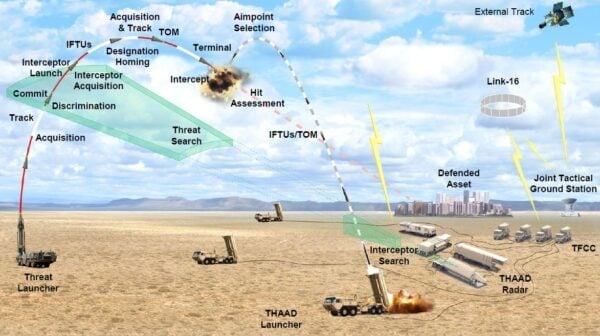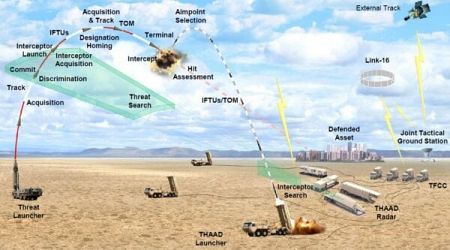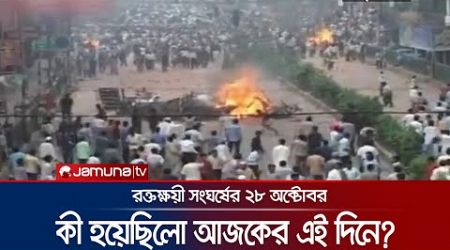Notes on the THAAD System
After over 500 ballistic missiles demonstrated a historic threat to city centres and thoroughly established a Causus Belli, the United States’ responded to future threats by erecting a THAAD site in the Middle East. In past conflicts, a signifi

This graphic shows how the THAAD system is networked via fiber optic cables to its various components to detect, identify, and engage an incoming missile. The THAAD missile, called an interceptor, has no warhead or explosives. Instead, it uses “kinet… (Photo Credit: U.S. Army)
After over 500 ballistic missiles demonstrated a historic threat to city centres and thoroughly established a Causus Belli, the United States’ responded to future threats by erecting a THAAD site in the Middle East. In past conflicts, a significantly smaller SCUD threat in the 1991 Gulf War was a large factor in establishing a coalition of willing powers to challenge tyranny in the region. With ballistic missiles being a known threat during the Second World War via V-2 rockets, it has only been a recent phenomenon where a defence against such threats even exists. Even during the 1991 Gulf War, early Patriot missile systems were largely ineffective in intercepting SCUD missiles, despite the SCUD being significantly older technology and in a lot smaller numbers. A notable strike on US personnel in Saudi Arabia showed there was little defense against the SCUD if the launchers were not intercepted within minutes of the missile being made ready to fire. The invention of THAAD came from the motivation to have missile interceptors protect allied forces as well as innocent civilian populations as promised in 1991. With that technology finally becoming active, missile interception systems closely belongs to the era of the 2020s.
The THAAD system was mostly known previously for its deployment and political tension created around it in the Pacific region. With North Korea continuously demonstrating the range of their ballistic missile programs, THAAD was proposed to be introduced in Asia at the protest of China’s Government. THAAD is designed to target long range, high altitude rockets and intercept them in the upper atmosphere. THAAD would protect America itself from a massive attack, often eliminating large warheads that are designed to create a lot of area damage, but also could carry chemical and nuclear warheads. THAAD, if successful, would mirror Reagan’s Star Wars system, eliminating missiles at the highest arc of their trajectory, except being based on the ground. THAAD would work however, whereas Star Wars was a proposal well beyond the technology of its time.
Despite there being versions of Anti-Ballistic Missile (ABM) systems surrounding Moscow since the 1960s, there were no confirmed successful uses of these systems in combat until recent more modern missile systems demonstrated they could target and eliminate other active missiles. During the War in Ukraine, older ballistic missiles like the OKA were able to beat out more modern S-300, SA-11 and SA-15 systems designed to knock missiles out of the sky. Only the most modern missile systems are able to knock out Russian missiles, with a spotty success rate at best. THAAD will likely be more active in the region soon, and a true test of its capabilities will be established. The ability of THAAD to coordinate missile defense with other systems is significant, as the THAAD radar is extremely powerful and able to detect missiles being fired from across the entire Middle East.
The THAAD system may have a weakness if it is not coordinated and connected to smaller defensive missile systems/Anti-Air systems that can protect the THAAD site and radar from smaller missile and drone threats. Bleeding THAAD and other expensive and complicated systems of their missiles was experienced in Ukraine as Russia used low cost drones to drown the radar detection with multiple targets and use up crucial missiles that are needed against high speed targets, as opposed to slow, inexpensive drones and missiles. The THAAD system therefore should only be used for its main purpose, and other systems need to be married to it for its own defense and a proper long term layered defense of the protected territory. Taking out a THAAD or something claimed as equivalent like a Russian S-400 system is a significant victory, as it shows that the territory cannot be protected and a new strategy needs to be initiated and installed, a task that can take a large amount of time in a difficult and ever expanding conflict. Suffering a missile barrage, even if defended successfully, allows the enemy to better target vital resources and civilians the next time around, and requires a defensive capability along with offensive action. The result of failures has already demonstrated the brutality of conflict when missile defense is relied upon too much and a military becomes complacent in war.


































